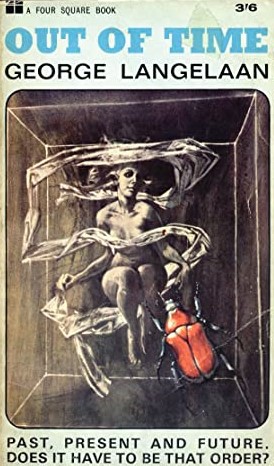 By GEORGE LANGELAAN (The New English Library; 1964)
By GEORGE LANGELAAN (The New English Library; 1964)
This uber-rarity is, as of 2021, the sole English language collection by George Langelaan (1908-1972). Langelaan was a French-British writer known as much for his real-life exploits, which included an association with Aleister Crowley and much derring-do as a WWII secret agent (recounted in the book THE MASKS OF WAR), as he was for his fiction. Not that that fiction wasn’t worthwhile, as its potency is amply proven by OUT OF TIME.
It consists of nine stories, all of the science fiction variety. First up is Langelaan’s most iconic tale “The Fly,” which was adapted for film twice. In short story form it’s quite strong, and effectively sets the tone for the rest of the book, whose stories, like this one, tend to be admirably focused, well plotted and related after the fact, either by a third party or in the form of a memoir written by a protagonist who’s found dead at the story’s beginning. The protagonist here is Andre, whose corpse is found with its head crushed by a large steam hammer. Andre’s wife Helene is suspected of the killing, but gives Andre’s brother a manuscript that describes what really occurred, which involves teleportation, head swapping and a pesky fly. A gripping and imaginative tale that’s marred only by a rather glaring implausibility (how is that the two transposed heads, one human and one not, share the same brain?).
Other standout tales include the novella-length “Past the Time Barrier,” about an unholy scientific experiment that results in its subject, a hapless man, being thrust into a realm where the laws of physics appear to have been suspended, or at least slowed down appreciably. Langelaan’s descriptive powers are utilized superbly, and the explanation for all the strangeness, while not nearly as mind-blowing as it probably once seemed, is potent (the story is dedicated “To the memory of all future victims of relativity”). Equally powerful is “The Lady from Nowhere,” adapted to the screen in the 1975 Romanian film HYPERION, that contains a phantom TV signal involving a beautiful woman from a distant time with whom the protagonist falls in love.
Also worthwhile is “Recession,” a thorough exploration of the idea that “Death is but a recession.” In “The Other Hand” a man’s right hand rebels against his body’s dictates and starts a revolution among other peoples’ hands (why do I think Clive Barker might have read this story?). “Parkson’s Last Flight” is something of a change of pace, a somewhat Robert Aickmanesque horror story in which an airline pilot’s subconscious apprehensions become concrete in the form of a monstrous bird. “The Drop of Forgetfulness” involves a man murdering his shrewish wife in a manner appropriate to the fact that she behaves in an extremely cat-like manner.
Lesser entries include “The Devil His Due,” an uninvolving account of the murder of a ghost. There’s also “Armchair detective,” an uninspiring murder mystery narrated by a dog, and “The Miracle,” a confused riff on the concept of faith healing. Overall, though, this is a worthwhile collection by a uniquely talented author. If only it were easier to find.
